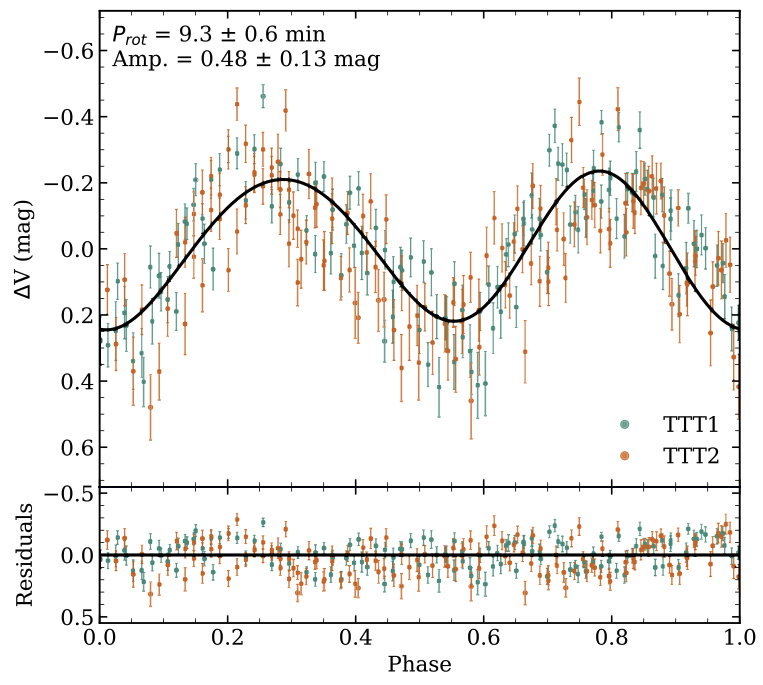AsteroiDB: The Asteroid Legacy Archive of the Canary Islands Observatories
- 1Instituto de Astrofisica de Canarias, Spain (mra@iac.es)
- 2Universidad de La Laguna, Spain
- 3Light Bridges S.L.
The growing volume of astronomical data produced by telescopic facilities presents significant challenges and extraordinary opportunities for the scientific community. Specifically, the Canary Islands Observatories generate approximately 1 petabyte of raw images annually from nearly thirty telescope installations, both public and private. These images are released into the public domain after a standard proprietary period of one year, enabling a variety of targeted research initiatives. In this communication, we introduce AsteroiDB, a dynamic and comprehensive catalog of asteroid photometry in the visible spectral range, compiled from archival images taken by various telescopes and instruments at the Canary Islands Observatories. To facilitate this, we have developed a series of innovative, open-source algorithms optimized for CUDA-based graphics processing units (GPUs). These kernel-based algorithms are designed to enhance the efficiency and speed of processing, calibration, and detection of point objects, and to accurately determine their astrometry and photometry. A brief introduction to the key aspects of these algorithms will be provided, followed by a demonstration of their performance across various GPU models.
The archive from the TTT1 and TTT2 telescopes, located at the Teide Observatory, has been processed to date. These are privately funded 80-cm telescopes that employ two distinct instruments: a CCD camera iKon936-L BEX2-DD (g+r, ugriz filters) with a field of view (FOV) of 17.3 x 17.3 arcmin, and a CMOS camera QHY411 (g+r, gri filters) with an FOV of 39 x 52 arcmin. Since March 2023, a total of 7,500 hours of observation have been conducted, resulting in the processing of 320,000 images (400 TB of data). This has yielded 950,000 photometric data points from 12,000 unique solar system objects, with 1,500 of these objects observed more than 100 times.
This communication presents preliminary results of the photometry, including data from additional telescopes such as the forthcoming Transient Survey Telescope (TST), a 1-meter wide-field telescope scheduled to begin operation in May 2024, and the prototype of ATLAS-Teide, the fifth node of the asteroid impact early warning system ATLAS, which will be installed at the Teide Observatory by the end of 2024. Furthermore, we will present research that has already made use of this data–e.g. Popescu et al. (2023) or de la Fuente Marcos et al. (2024), see Fig. 1. Additionally, we will discuss new investigations that are currently underway. Furthermore, the AsteroiDB User Interface will be introduced, which allows for dynamic access to the database, the addition of new datasets from other photometric catalogs, and the retrieval of detailed information on rotation periods or phase curves, among other features. Future prospects include integrating all other telescopes at the Canary Islands Observatories equipped with imaging instruments into the catalog and conducting specific studies on solar system science, with a particular focus on the Near Earth Asteroid population.

Figure 1. Phased light curve of 2023 FY3 derived from photometric measurements obtained by the TTT1 and TTT2 telescopes. The object was at mV = 18.4 at the moment of the observation, continuous exposures of 6.5-sec were taken using the sCMOS camera QHY411. The rotation period and amplitude of the curve are shown at the upper left. Reproduced from de la Fuente Marcos et al. (2024).
References
Marcel M. Popescu, O. Văduvescu, J. de León, C. de la Fuente Marcos, R. de la Fuente Marcos, M. O. Stănescu, M. R. Alarcon, M. Serra Ricart, J. Licandro, D. Berteşteanu, M. Predatu, L. Curelaru, F. Barwell, K. Jhass, C. Boldea, A. Aznar Macías, L. Hudin and B. A. Dumitru. Discovery and physical characterization as the first response to a potential asteroid collision: The case of 2023 DZ2. A&A, 676 (2023) A126. https://doi.org/10.1051/0004-6361/202346751.
de la Fuente Marcos, C. de la Fuente Marcos, J. de León, M. R. Alarcon, J. Licandro, M. Serra-Ricart, D. García-Álvarez, A. Cabrera-Lavers. When the horseshoe fits: Characterizing 2023 FY3 with the 10.4 m Gran Telescopio Canarias and the Two-meter Twin Telescope. A&A 681 A4 (2024). https://doi.org/10.1051/0004-6361/202347663.
How to cite: R. Alarcon, M., Licandro, J., and Serra-Ricart, M.: AsteroiDB: The Asteroid Legacy Archive of the Canary Islands Observatories, Europlanet Science Congress 2024, Berlin, Germany, 8–13 Sep 2024, EPSC2024-640, https://doi.org/10.5194/epsc2024-640, 2024.